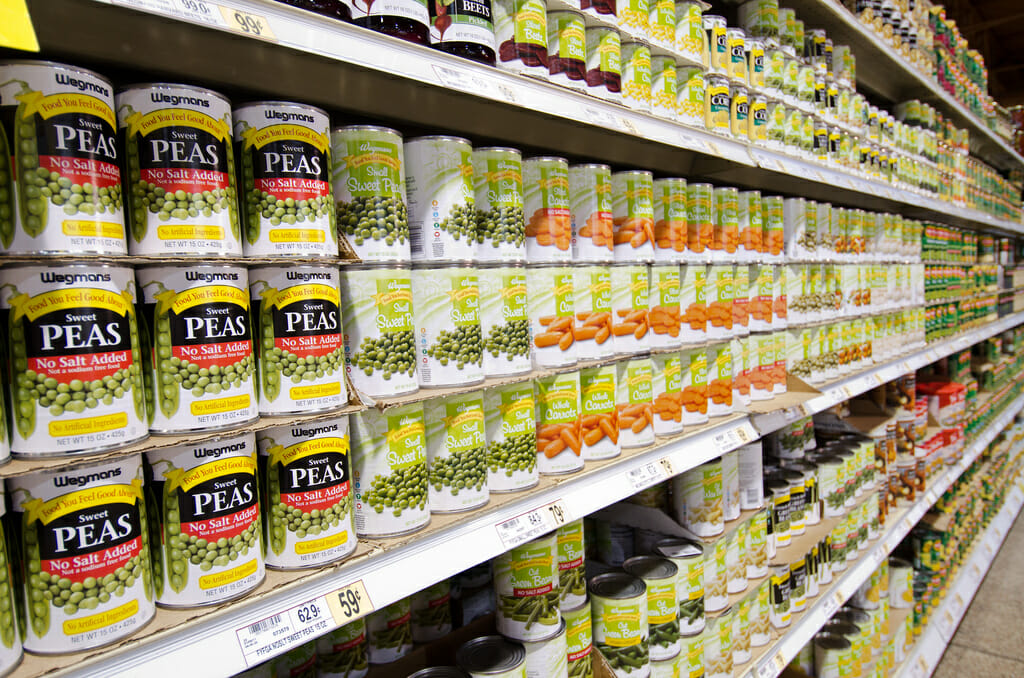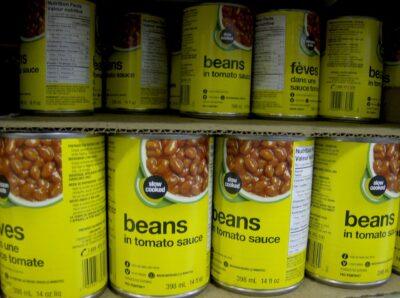Have you ever wondered how long store-bought canned good will last in your stockpile? Professional food processors and manufacturers have both the equipment and knowledge to properly preserve food — plus the tests and inspections from the federal government.
However, most canned foods are packed in water. That makes a big difference. Water or any other liquid can potentially become a petri dish for future bacterial growth. This is especially true for home canning, but we’ll get to that later.
pH 101
pH is a measure of the acidity or alkalinity of any food. Foods with a higher acidity (measured on the pH scale as between 0 and 4.6) form a natural barrier to bacteria and require simple processing and less processing time, but the acids can quickly compromise the integrity of a can or jar lid and the food itself. These foods include:
Juices (tomato, orange, lemon, lime and grapefruit); tomatoes, grapefruit, apples and apple products like apple sauce, mixed fruit, peaches, pears, plums, all berries, pickles, sauerkraut; foods treated with vinegar-based sauces or dressing like German potato salad and sauerbraten.
Quite often, these kinds of canned goods will have a white plastic coating on the inside of the can to prevent corrosion.
Are Your Prepared For A Downed Grid? Get Backup Electricity Today!
Foods with a high level of alkalinity require more complex processing under pressure and longer processing time, but those robust processing steps actually add to the shelf life with no danger of internal acidity compromising the can or lid on a glass jar. These foods include:
Canned meats, poultry, stews, soups except tomato, pastas in sauce, potatoes, corn, carrots, spinach, beans, beets, peas and pumpkin.
What becomes clear is that you can’t lump all store-bought canned goods together in your storage area with long-term food products and assume all be well. You’ll have to separate them and write on the label or can the purchase date and the shelf-life. In fact, you should do this with all food stores, including long-term foods and most definitely with any home canning.
What About Expiration Dates?
Are expiration dates for real? Yes and no, Even the USDA says that expiration dates are suggestions or recommendations rather than a hard-and-fast rule or deadline. The reason is that so many factors can affect the shelf life of food. In fact, the dates on packaged goods aren’t referred to as expiration dates but “sell by” or “best by” dates.
Even then, some products don’t have any of these dates but instead a cryptic combination of letters and numbers. These are usually codes to indicate the point of origin for a particular product in the event of a recall.
The other truth is that a product does not suddenly go bad when it reaches its “best by” date. In fact, many canned goods are edible and safe for years after a “best by” date if stored properly. But be careful out there.
Several factors affect the storage of foods:
The temperature that any food is stored at is the most critical factor impacting shelf life. The standard recommendation is a temperature between 50 and 70 degrees Fahrenheit for canned goods. The lower the better, but don’t go below freezing; also, any canned food stored at or above 85 degrees Fahrenheit will quickly degrade and potentially become unsafe to eat
Temperature Extremes
Variations in temperature in an environment where you are storing any food is perhaps the greatest threat to shelf life. This is particularly true if any food goes through a pattern of freezing and thawing over a period of months or even years, and the freezing can complicate things, given that most canned food is preserved in water. The end result is often a tasteless mass of grey mush in a can bursting at the seams. Bulging cans are also a sign of bacterial contamination.
That’s why storing any food in an attic space, an unheated or unventilated garage or any other area subject to winter/summer temperature extremes is a bad idea. A root cellar is fairly stable, and a home basement, as long as water or moisture are properly managed, is fine, too. A dedicated pantry also works, and it may encourage you to engage in a recommended practice for food storage.
Eat What You Store!
“Eat what you store and store what you eat.” This is a very good idea, but I must admit I have a hard time doing it with long-term food storage. Long-term foods are usually dried foods in big, No. 10 cans, and my kitchen pantry only has so much room. I do have a No. 10 can of macaroni and a No. 10 can of cheese powder on the bottom shelf in the pantry, but that’s because my kids eat mac and cheese like wolverines.
On the other hand, I’m not real anxious to use taco flavored TVP (textured vegetable protein) as an everyday food on my tacos when I can still get a pound of ground beef and taco seasoning at the grocery store. And that starts to point to the desire to supplement long-term food stories with grocery-store canned foods.
Here’s six things to watch for when purchasing canned goods from the grocery store:
- Don’t buy or store a dented can. It’s more likely to be exposed to air, and bacteria will soon follow.
- Check any can or jar lid for corrosion. If you can wipe it off you may be okay, but you should probably toss it.
- If a can is bulging or the contents spurt out when you open it, stand back and put it into a double plastic bag and get rid of it. That could be sign of botulism and it could kill you if you consume it.
- Smell the contents after opening. If you detect any kind of off-odor, throw it away.
- Observe the color. Are the orange peaches a pale yellow? Are the dark, red kidney beans a shade of grey? It may be okay to eat, but boil it first.
- Boil all canned goods if they have been stored for a long time, and then smell and taste afterward. Acid foods should be boiled for 10 minutes and alkaline foods for 20. This will kill most residual bacteria, but will probably not kill any botulism microbes or spores.
Here’s a chart you can print and put up in your long-term food storage area if you are storing store-bought canned goods. These recommendations were made by the USDA:
| FOOD | STORAGE ON SHELF | NOTES |
| Canned Ham | 2 to 5 years | |
| Low-acid canned foods: Canned meats, poultry, stews, soups except tomato, pastas in sauce, potatoes, corn, carrots, spinach, beans, beets, peas, pumpkin. | 2 to 5 years. | Low-acid foods have a pH level of greater than 4.6. They require high-pressure processing and longer processing times but have a better shelf-life |
| High-acid canned goods: Juices (tomato, orange, lemon, lime and grapefruit); tomatoes, grapefruit, apples and apple products like apple sauce, mixed fruit, peaches, pears, plums, all berries, pickles, sauerkraut; foods treated with vinegar-based sauces or dressing like German potato salad and sauerbraten. | 12 months. To 18 months | High-acid foods have a pH of 0-4.6 and only require water-bath processing but have a lower shelf-life due to the effect of acids deteriorating both product and can, or jar/lid integrity over time. |
| All home-canned foods | 12 months. Before using, boil for 10 minutes for high-acid foods; 20 minutes for low-acid foods. Add one minute for every 1,000 feet above sea-level. | Home canned foods are potentially the most dangerous from a food contamination standpoint if not processed properly. The shelf life is limited to one year. |
Do you agree or disagree? Share your thoughts on storing cans long-term in the section below:
 Off The Grid News Better Ideas For Off The Grid Living
Off The Grid News Better Ideas For Off The Grid Living





